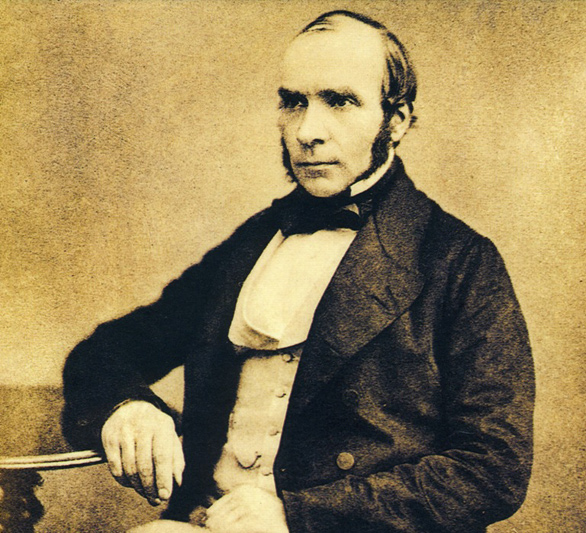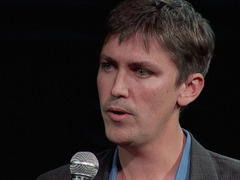 Shanghai. New York. Tehran. Tokyo. Today, dozens of cities worldwide are each home to many millions of people. But those masses of humanity might not exist in such tight quarters if not for John Snow. (No, not that Jon Snow. This John Snow.)
Shanghai. New York. Tehran. Tokyo. Today, dozens of cities worldwide are each home to many millions of people. But those masses of humanity might not exist in such tight quarters if not for John Snow. (No, not that Jon Snow. This John Snow.)
Snow was a 19th-century English doctor who’s credited with proving that cholera, a sometimes deadly infection that attacks the small intestine, spreads through contaminated water — and not by “bad air” as was generally believed at the time.
 Steven Johnson: How the "ghost map" helped end a killer disease
As described in Steven Johnson’s 2006 TED Talk, “The Ghost Map,” a particularly vicious cholera outbreak in 1854 at a popular water pump in London killed an astonishing 10 percent of the people who lived nearby. Snow created a map showing which people had consumed the water from the pump and whether they had gotten sick. His map helped convince local health authorities that his theory was the correct one, and by the next severe outbreak in 1866 they officially recommended that people boil water before drinking or using it, curbing the spread.
Steven Johnson: How the "ghost map" helped end a killer disease
As described in Steven Johnson’s 2006 TED Talk, “The Ghost Map,” a particularly vicious cholera outbreak in 1854 at a popular water pump in London killed an astonishing 10 percent of the people who lived nearby. Snow created a map showing which people had consumed the water from the pump and whether they had gotten sick. His map helped convince local health authorities that his theory was the correct one, and by the next severe outbreak in 1866 they officially recommended that people boil water before drinking or using it, curbing the spread.
March 15 marks the 200th anniversary of Snow’s birth, which the London School of Hygiene & Tropical Medicine and affiliates are celebrating in a series of meetings and exhibits. Our present to Snow? We spoke to author Steven Johnson about the impact the doctor has had on the sustainability of modern cities.
When did you first discover the story of John Snow and his cholera map, and what was your first reaction to it?
I first came to it as an information design story in Edward Tufte’s amazingly beautiful design books, and then I kept encountering it in other fields. I’d be reading about a history of epidemiology and I’d stumble across it, or I’d be reading about the history of disease and would stumble across it. I think that is what makes the story and Snow’s role in it so interesting — the way it connects to so many fields.
What were other characteristics of the story that made you decide to write The Ghost Map?
It turned out to fit my expectations or visions of a beautiful story about the interaction between different scales of experience. It’s a story in some ways about the collusion of bacteria and the flow of water: the clean drinking water, contaminated drinking water, and waste in this huge stinking metropolis — the biggest city the world had seen at that point, with two and a half million people. Between those two scales — basically the smallest form that life takes on the planet and in some ways the largest form, the metropolis — you have this individual who’s trying to make sense of patterns that are happening in the city and trying to connect them to patterns and behavior that is happening on a microscopic scale that he can’t even see. That’s crucial to the story — that he cannot see the bacterium. He has to infer its existence from the patterns he’s detecting in the streets of London.
Once I actually sat down to research it, there were a number of things that I found that surprised me and that had not been in the traditional telling of the story. It’s conventionally told as: Snow made the map, he saw the pattern of death pointing to the pump, and he developed the waterborne theory. But in fact, he’d been working on the waterborne theory for a very long time. The map was a marketing vehicle for his idea.
The other thing was the important role, which is very relevant today, of public data. The city had begun releasing more complex mortality reports a decade before the outbreak, and instead of just listing so-and-so died on this date, they would list so-and-so died of this age, this gender, this disease, this exact address. Whatever data they had, they would release in these reports. The whole premise was: You create more data, you release it to the public, and the city is filled with all these interesting amateurs who don’t work for the government who might detect patterns in it. Snow ended up using a lot of that data, in addition to his on-the-ground detective work to build a map, to build his case for the waterborne theory. It’s very much connected to the kind of open data, transparency argument of today. Snow was doing it without computers, but it’s the same idea. So that was a cool surprise.
Finally, Henry Whitehead, Snow’s collaborator. I mean, almost nobody talks about him, and he was crucial to the story. The more I dug in, the more I realized that Whitehead had done all this work Snow really couldn’t have done, because Snow was not a great social connector. A lot of the investigation needed Whitehead’s social intelligence to track down additional data on people who had left the neighborhood. And there’s an argument that without Whitehead’s contributions, the authorities might not have come around to Snow’s theory. I love that because it’s a great example of multidisciplinary collaboration where you have two very different types of intelligence coming together to solve a problem.
In your TED Talk, you mention that modern, massive cities that exist today wouldn’t be possible without Snow’s contributions to epidemiology. Can you elaborate?
This is why the period is so interesting in a sense. There were all these people looking around London in 1854 and saying: This is not sustainable. Human beings are not meant to live in this state, two and a half million people is just too large for a city to work. And they were right on some level — certain things had to be figured out that hadn’t been yet.
One of the biggest was how to deal with all the human waste that is created with two and a half million people so densely populated. [Snow helped make] it clear that the separating of drinking water and waste was an absolute imperative for the city to grow. Making it clear that that could happen — and conquering cholera within 12 years — is just a staggering achievement. And that became a blueprint for every big city in the world. It enabled us to build cities of 10 million and 20 million people without necessarily having to battle these diseases.
Now, developing-world megacities are trying to figure it out with 25 million people. And we haven’t solved all those problems. But one of the things that is so important about Snow’s achievement is that it wasn’t all that long ago. You look back 160 or 170 years and you can point to how awful London was as a city, and compare it to the amount of progress we’ve made since then, and use it as a kind of inspiration for what we need to do now.
That nicely leads to my next question. What are the main challenges these new megacities face?
The root cause is that the growth in these megacities is coming in areas without traditional infrastructure. When you look at the favelas in São Paulo, you have millions and millions and millions of people without a traditional electric grid, without traditional sewage, in improvised communities. It may be that the way to deal this is to just build infrastructure and support them in a traditional way that we pioneered in the 19th century. Or maybe there are new solutions.
Are there mapping tools that are the modern-day, John Snow/cholera equivalent that are helping solve some of these problems?
There are actually. There are a million examples of things like this, precisely because we now have Google Maps where we can drop datasets and anybody can do new dynamic maps of interesting social problems. There were some great improvised maps that were created after the earthquake and cholera epidemic in Haiti.
You just got back from TED2013 in Long Beach, California. What was the most memorable moment for you?
There was a talk by Alastair Parvin about this kind of open-source Creative Commons kit for building small houses, where two people with a 3D printer can assemble one in 48 hours. It was really cool, and his point was about releasing tools so that anyone can build a structure in those developing world megacities that we are talking about. An overwhelming number of the houses are actually built by members of the community cobbled with existing materials. If you have this kind of technology, it helps produce more reliable housing. And I kind of thought, that is a great. That fits perfectly with the Ghost Map.
Additional reading:
Haven’t had enough John Snow? For more, check out the UCLA Department of Epidemiology’s John Snow archive, which has original writing and images, as well as other treats, or try these books:
The Ghost Map: The Story of London’s Most Terrifying Epidemic and How It Changed Science, Cities, and the Modern World by Steven Johnson
The Strange Case of the Broad Street Pump: John Snow and the Mystery of Cholera by Sandra Hempel
Cholera, Chloroform and the Science of Medicine: A Life of John Snow Peter Vinten-Johansen et al.
Comments (5)
Pingback: The 1855 Map That Revolutionized Disease Prevention & Data Visualization: Discover John Snow’s Broad Street Pump Map - Online Programs
Pingback: Geo NYC: Mapping the Environment | JeffreyBarke.net
Pingback: Mapping Life and Death in Victorian Soho | Fluid Lives
Pingback: Fact Sheet: 2013 Members of Distinction (DFA – Dairy Farmers of America Inc) | eJumo